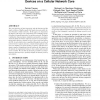Free Online Productivity Tools
i2Speak
i2Symbol
i2OCR
iTex2Img
iWeb2Print
iWeb2Shot
i2Type
iPdf2Split
iPdf2Merge
i2Bopomofo
i2Arabic
i2Style
i2Image
i2PDF
iLatex2Rtf
Sci2ools
CCS
2009
ACM
2009
ACM
On cellular botnets: measuring the impact of malicious devices on a cellular network core
The vast expansion of interconnectivity with the Internet and the rapid evolution of highly-capable but largely insecure mobile devices threatens cellular networks. In this paper, we characterize the impact of the large scale compromise and coordination of mobile phones in attacks against the core of these networks. Through a combination of measurement, simulation and analysis, we demonstrate the ability of a botnet composed of as few as 11,750 compromised mobile phones to degrade service to area-code sized regions by 93%. As such attacks are accomplished through the execution of network service requests and not a constant stream of phone calls, users are unlikely to be aware of their occurrence. We then investigate a number of significant network bottlenecks, their impact on the density of compromised nodes per base station and how they can be avoided. We conclude by discussing a number of countermeasures that may help to partially mitigate the threats posed by such attacks.
| Added | 19 May 2010 |
| Updated | 19 May 2010 |
| Type | Conference |
| Year | 2009 |
| Where | CCS |
| Authors | Patrick Traynor, Michael Lin, Machigar Ongtang, Vikhyath Rao, Trent Jaeger, Patrick Drew McDaniel, Thomas F. La Porta |
Comments (0)

